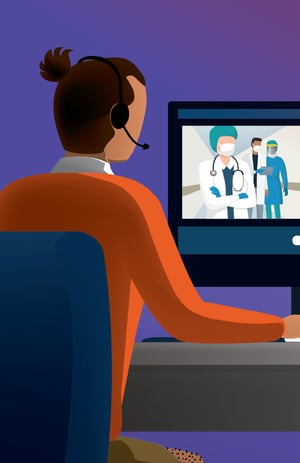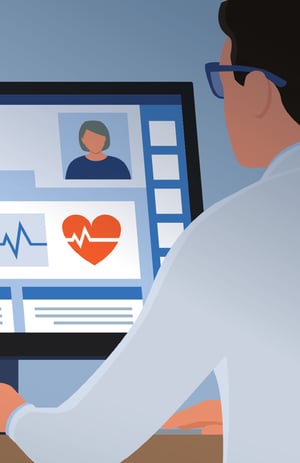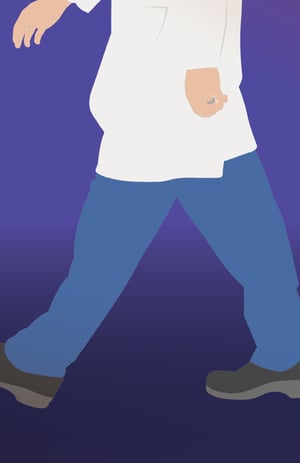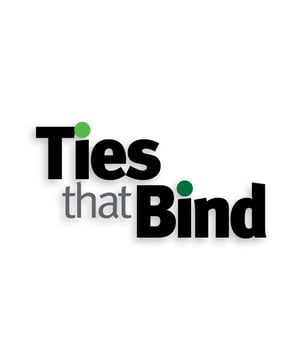April 2025
The Blip: A Five-Year Retrospective
on the COVID-19 Pandemic
Table of Contents




My COVID Pandemic Reflection
The COVID pandemic warped my sense of time. I find it hard to believe that the first shutdowns began five years ago. As I look back, I am immensely proud of how ProAssurance responded to the pandemic, both on behalf of our team members and our insureds. We found tremendous resiliency in each other and in our ability to redefine, sustain, and build on in-person relationships. We found strength in our willingness to lean on one another for support and encouragement.
When I reflect on the outcomes of the pandemic, two topics come to mind.
First, unlike many who think the most lasting impact from the pandemic was the pivot to remote work, I think the most lasting impact has been an outcome of that transformation. Today, operating and communicating remotely have become a core component of how we do business.
When we first moved to remote work and the distance it put between us, I worried that our culture would suffer. Instead, while being in person remains important, I have seen a new culture emerge. This new culture embraces the freedom and flexibility of remote and hybrid work while simultaneously building relationships in new ways and developing new avenues of support. This embrace of new ways of doing things has, in my view, amplified our innovation efforts and ultimately made us a stronger company.
Second, I remain concerned about the lingering impact of COVID on our insureds in terms of an unfortunate distrust in our healthcare system. This distrust appears to be impacting the delivery of care and the provider-patient relationship while also negatively influencing the litigation environment.
Five years ago I said, “Our healthcare system is being tested in a way we have never seen before, and yet people show up day after day to serve others. It is truly inspiring, and we are grateful for the opportunity to support them and our communities whenever we can.”
In the early days of the pandemic, many referred to those in our healthcare community as heroes, and indeed, they are. This was especially seen in the early days of the pandemic when so little was known about the disease. The selflessness with which they responded was truly inspirational, and it is unfair that the tide turned against them so quickly.


The New Normal
Looking back at COVID-19, our society and business have changed dramatically. The most obvious from a business perspective is the “work from home” situation. We never envisioned an immediate 100% remote workforce and a largely remote workforce today. Our team members are located much more widely.
Relative to Underwriting and Claims, we have both returned to normal and will never be normal again. With Underwriting, we reduced premiums for many insureds whose practices were disrupted by COVID, affording them some relief as their revenues were dramatically reduced. We did not see a massive movement of insureds between carriers, as their insurance wasn’t at the forefront of their concerns. For Claims, the immediate and long-term effects were significant. First, the number of claims dropped as many types of care were delayed. For example, elective surgeries virtually ceased for a considerable length of time. Claims counts did rebound to pre-COVID levels after care patterns returned to normal, but those “missing” claims remained as such with very little in the way of a “catch up” spike.
The most material effects were in claims resolution. Claims closure patterns were materially disrupted, delaying our ability to clear claims from the rolls. This fact combined with the increasing cost of claims leading up to and following COVID-19 created uncertainty about ultimate results, making financial estimates much more difficult.
In some ways, our favorable MPL results from 2024 were the result of this difficulty in estimating appropriate reserve levels in prior years. Basically, resolution took longer and has worked out a bit better than the initial post-COVID estimates. Of course, the addition of NORCAL following COVID-19 increased the volume effects of that uncertainty. We are just now seeing claims closures back at pre-COVID normal levels.
Generally, the claims volume (frequency) has moderated since 2020 with a slight decrease from pre-COVID levels, which is a bit of a surprise but a good one. We know that some of that moderation resulted from our strong reunderwriting efforts during 2020–2021, but we have observed a general moderation as well. Frequency has remained flat since 2021, and severity has continued to increase materially.
While some physicians, indeed, chose early retirement, many did not quit medicine but joined larger groups that could take the administrative burdens from them. That continued and possibly slightly accelerated the trend of consolidation of physician practices. Today, many estimate that only 20% of physicians own their practices.
This is our “new normal.”


Reflecting on the COVID-19 Pandemic Five Years Later
COVID-19 turned the world on its head in 2020, and people around the world have adjusted their personal and professional lives since that year. We asked our ProAssurance team members and agency partners where they felt repercussions from the pandemic. Our questions ranged from the short- and long-term pandemic impacts to how COVID-19 has affected the professional liability insurance space.
“I feel that it changed the landscape to an extent. Several physicians retired early, and we aren’t seeing as many new physicians entering into practice. I also am seeing fewer dedicated ER physicians and Hospitalists and more Internal Medicine physicians moonlighting in hospitals.”
- Crystal Fahrenkrug, ProAssurance Senior Underwriter
“It slowed down the claims process initially, but that has since returned to the normal rate.”
- Mark Alighire, ProAssurance Midwest Underwriting Manager
“I continue to see more telemedicine.”
- Kate Sorge, ProAssurance Underwriter
“We are still feeling the ripples from the stress that it put on the system and personnel. I believe that this has been the single biggest impact of the pandemic on the overall healthcare industry. Sadly, it also eroded the public’s faith in the system.”
- Peter Reilly, HUB International
“We haven’t seen any appreciable claims activity due to the care delivered related to COVID-19.”
- Christian Chivaroli, Chivaroli & Associates
“We have honestly not seen much impact from COVID-19 as far as MPL goes in Texas or Louisiana. I think there was a concern or fear early on in 2020 and 2021, when we saw carriers pushing rate in anticipation of everything going haywire from COVID-19. But to date, I don’t think I’ve seen a single claim mentioning COVID-19 or anything related to it. I do think it opened a lot of people’s eyes to the potential for a catastrophic disease to overload the medical community. It certainly led to a lot of burnouts and early retirements.”
- Tiffany Zumwalt, Madeley & Company
“I believe that it has opened the door for more providers to pursue telemedicine within their practice.”
- Janis Taylor, Gregory & Appel
“In hindsight, COVID-19 was an unmitigated disaster, with many aspects of the pandemic proving flawed and almost nonsensical. For example, the requirement to wear masks when entering restaurants, only to remove them once seated, highlighted the inconsistencies in public health measures. Similarly, the effectiveness of vaccinations remains questionable, and the long-term impact on children is still being felt. The professional liability landscape was directly affected by the pandemic as courts closed and the flow of claims was halted. This pause created a rebound period in which healthcare professionals, particularly doctors, were seen as frontline responders, putting their lives on the line. As a result, fewer claims were filed, due to the heightened public support and admiration for physicians. However, this shift in sentiment has dramatically changed in recent years. Plaintiffs and juries are once again angry, frustrated with the system, and holding healthcare providers more accountable. Additionally, some insurance companies were given the opportunity to ‘weather a financial storm’ due to the temporary closure of courts, which delayed claims and legal proceedings. However, this merely postponed the inevitable, with some carriers ultimately facing financial struggles as the underlying issues remained unaddressed. While COVID-19 temporarily shifted the professional liability landscape, the aftermath has been marked by a more litigious environment, with increasing frustration from plaintiffs and a strain on the financial stability of some insurance providers.”
- Chris Zuccarini, Risk Strategies
“I had to adjust to working from home. I wasn’t completely equipped properly, nor did I have the correct setup for working from home at that time. It also had a sharp impact on my mental health as I was also trying to manage my daughter’s schooling from home at the same time. The dual roles competed for my attention, and it was very stressful.”
- Crystal Fahrenkrug, ProAssurance Senior Underwriter
“The impacts were major. I was living in Seattle, Washington, and decided to move to Colorado—mainly to get away from the chaos that was happening in the Seattle area due to COVID-19 and rioting.”
- Kate Sorge, ProAssurance Underwriter
“Working from home was a major, short-term impact. The process of learning new software, new working techniques, and different ways to solve new problems took time.”
- Jonathan Whitman, ProAssurance Claims Reinsurance Liability and Analytics Vice President
“I was working full time at home with a toddler. The balance and overlap of personal and professional lives were nearly impossible to separate. I enjoyed the freedom to work when I could, but I missed the structure and personal contact I had with my colleagues at ProAssurance in the Birmingham office.”
- Mallory Earley, ProAssurance Assistant Vice President of Risk Management
“We were in the process of transitioning to hybrid work, and COVID-19 sped that up. It allowed for more freedom from the external work stress, such as a daily commute.”
- Mark Alighire, ProAssurance Midwest Underwriting Manager
“It was the most meaningful and exciting period of my professional career. Every day was a chance to make a difference. A couple of days, I think we actually did.”
- Steve Dapkus, ProAssurance Senior Vice President, Marketing and Risk Management
“Having to work from home was a challenge, and I lost touch with clients to an extent.”
- Anonymous
“Aside from balancing working from home with a 2-year-old running around, it was pretty easy to transition. I prefer coming to the office to work as I feel more focused, but as a result of COVID-19, I found I can work from anywhere now. It definitely requires having a good setup to work remotely.”
- Tiffany Zumwalt, Madeley & Company
“We had a significant number of clients cancel or pause coverage, resulting in significant revenue losses during that period.”
- Chris Zuccarini, Risk Strategies
“It was very isolating and made both internal and external communication awkward.”
- Peter Reilly, HUB International
“Yes! The office that I worked from ended up closing down with the company reorganization, so I was assigned to a different region to work. Because I knew at that point working from home was going to be permanent, I took the time and spent the money to dedicate a proper office in my house to work. This included buying a desk and an ergonomic chair for me as well as dedicating the money needed to make sure I had the right resources I needed to effectively do my job. I invested in a printer, some storage to keep my office organized, and some basic office supplies. Feeling like I have an organized and professional environment to work in has dramatically improved my mental ability when it comes to work. My new setup has a window where I get lots of natural light every day, and I have a calming environment. It has had a great impact on my mental health and allowed me to focus on my work. I feel overall it has increased my work productivity.”
- Crystal Fahrenkrug, ProAssurance Senior Underwriter
“I have learned to do more with less. I work more hours than before COVID-19, because it takes more time to get things completed.”
- Jonathan Whitman, ProAssurance Claims Reinsurance Liability and Analytics Vice President
“The job I was initially hired to do at ProAssurance—travel around the country to deliver in-person education to physicians—no longer exists. I am pleased with the ways in which Risk Management has evolved, but I think changing the job description for necessity was not something I had anticipated.”
- Mallory Earley, ProAssurance Assistant Vice President of Risk Management
“As long as we can remain ‘mostly remote,’ I will function as expected. My long-COVID-19 issues directly impact my ability to drive for more than 20 minutes. I got COVID-19 from a family member in November 2020, and now I suffer from long-term symptoms that affect my personal life.”
- Anonymous
“My previous employer closed the office I was working at prior to COVID. We had no idea how long we would be working from home. However, it was a blessing for me, because I was able to keep my original job and work remotely. This would not have been an option before the pandemic.”
- Kate Sorge, ProAssurance Underwriter
“A long-term effect has for sure been the rise of remote work. I prefer the in-office environment, even as I realize this is a permanent change.”
- Steve Dapkus, ProAssurance Senior Vice President, Marketing and Risk Management
“Yes and no. COVID-19 had significant ramifications in the way we do business, such as the vast majority of our staff working remotely. I don’t view this as a positive change.”
- Anonymous
“We tend to be more cautious when someone in the office is sick. There is a lot more flexibility to work from home when sick, so work can still get done but also rest while feeling bad. We would rather the person work from home if there are symptoms that are questionable. But honestly, this is not limited to just COVID-19—it is across the board with flu, strep, RSV, etc.”
- Tiffany Zumwalt, Madeley & Company
“Using virtual meetings has made me more efficient and allowed me to expand my territory.”
- Joe Vonderhaar, USI
“The number of questions regarding staffing (recruiting and retention) has increased. Additionally, the greater use of technology has raised more IT/cyber questions.”
- Peter Reilly, HUB International
“We are so grateful to be a business that is primarily focused on medical practices. As a result, we saw very little impact on operations because doctors didn’t close down like other businesses. We already had good relationships with most of our customers, and COVID-19 did not impact that at all. They did say they were happy to be able to get ahold of us easily.”
- Tiffany Zumwalt, Madeley & Company
“Regarding business operations, we saw a decline in staff wanting to come into the office on a regular basis. Our relationships with our clients didn’t show any changes.”
- Janis Taylor, Gregory & Appel
“I took up kayaking in the summertime during COVID-19 just so I could find an outdoor activity to get me out of the house. I have a beautiful lake about a half of a block from where I live, and I enjoy taking my kayak out on the lake and watching all the wildlife.”
- Crystal Fahrenkrug, ProAssurance Senior Underwriter
“My previous company gave us one day a week to make masks for the community. I don’t make masks anymore, but I do sew.”
- Kate Sorge, ProAssurance Underwriter
“I continue to prioritize exercising and taking walks outdoors, which was something I really looked forward to during the quarantine.”
- Mallory Earley, ProAssurance Assistant Vice President of Risk Management
“I still enjoy writing, completing puzzles, and reading.”
- Kaelin O’Reilly, ProAssurance Marketing Communications Specialist
“Binge watching TV was and is one of them. Still do it, and I love it.”
- Peter Reilly, HUB International
“My main hobby in the early pandemic was to leave Amazon packages outside for a couple of days to detox, but I have since reverted to opening them right away.”
- Steve Dapkus, ProAssurance Senior Vice President, Marketing and Risk Management
“I picked up cooking.”
- Christian Chivaroli, Chivaroli & Associates
“Puzzles. My mother passed in 2020 (not COVID-19 related), and so my father and I buy the same puzzle and race to see who completes it faster.”
- Tiffany Zumwalt, Madeley & Company
“Wordle.”
- Chris Zuccarini, RiskStrategies

The Post-Pandemic Impact on Senior Care
One of the long-term impacts of COVID-19 in Senior Care is that it permanently changed the landscape for occupancy. Many nursing homes closed, and occupancy has not fully recovered.
According to KFF, a leading health policy organization in the U.S., the number of nursing home residents decreased by 10% between 2015 and 2024, with a big drop from 2020 to 2021 due to COVID-19. While the number of residents is slowly rising again, it is still lower than before the pandemic. More people are now receiving care at home or in other community-based settings instead of nursing homes.
The number of certified nursing homes also decreased by 5% from July 2015 to July 2024. During this time, the average amount of nursing care hours per day dropped by 8%. The number of deficiencies per facility went up, and the share of facilities with serious deficiencies grew from 17% to 28%.
The number of workers at long-term care facilities is still below pre-pandemic levels. To help address the high mortality rates in Senior Care during the COVID-19 pandemic and ongoing staffing shortages in facilities, the Centers for Medicare and Medicaid Services (CMS) created a new rule. It set minimum staffing requirements for nursing homes in an effort to improve Medicaid services and long-term care.
While the pandemic posed significant challenges for Senior Care facilities, it has also sparked important changes that will shape the future of long-term care.

Priya Chidambaram and Alice Burns, “A Look at Nursing Facility Characteristics Between 2015 and 2024,” KFF, https://www.kff.org/medicaid/issue-brief/a-look-at-nursing-facility-characteristics/.
“Medicare and Medicaid Programs; Minimum Staffing Standards for Long-Term Care Facilities and Medicaid Institutional Payment Transparency Reporting,” Federal Register, https://www.federalregister.gov/documents/2024/05/10/2024-08273/medicare-and-medicaid-programs-minimum-staffing-standards-for-long-term-care-facilities-and-medicaid.

The Halo Effect
The halo effect: “the global evaluation of a person based on the perception of a single trait”*
In our August 2020 issue of ProVisions, we reported that 36% of surveyed Americans believed physicians work for the public good (up from 17% in 2005). That same survey showed 60% felt the same of nurses. Did this high esteem translate to a halo effect with impacts on jurors in malpractice trials during COVID? Is it still a thing post-COVID? Our Claims experts share their perspectives.
Barbara Hunyady, JD, Midwest Regional Risk Manager, had this to say:
"We talk about the halo effect a lot in litigation. I think it’s a real thing because it comes out in voir dire when questioning the jury. Historically, most jurors inherently trust doctors, defer to them, and the defendant doctor is almost always the most educated person in the room. That’s pretty powerful.
There was a lot of concern that, post-COVID, we would lose the halo effect. It may have been scuffed up a little, but I haven’t seen any real evidence of losing it altogether. Our trial success rate has stayed stable. Also, in the post-COVID trials I have been in, we were hearing some of the same comments from potential jurors during voir dire that we heard pre-COVID.
Do I think the halo effect is gone? No. We still hear from jurors that they have great respect for doctors and the work they do. Nonetheless, whether there is a halo effect or not, the risks at trial are also real. Given the trend of multimillion-dollar verdicts, when trials are lost, the damage awards can be devastating."
Frank Bishop, retired Regional Claims Executive, suggested there was a belief that there would be some goodwill and possibly healthcare professionals would be seen as healthcare heroes and get the benefit of any doubt by a jury. That never materialized. “There are several theories out there,” he said. “But in my opinion, the political divisions coming out of the 2020 elections (George Floyd, BLM, January 6, and other deeply emotional incidents) created a backlash of hate and contention for all things institutional, including the practice of medicine.”
Laura Ekery, Regional Claims Executive, Southwest Region, also suggested there was a hope that the COVID experience would lead to juror appreciation of dedicated healthcare providers who put themselves at risk to continue caring for patients during the pandemic. Instead, we often see results driven by anger, sympathy, or a desire to affix blame.
Gina Harris, Regional Claims Executive, Western Region, echoed the sentiments of her colleagues and further pointed to “a distrust of science and vaccines” as a factor against the hoped-for “halo effect” during COVID.

Healthcare Jobs – What Has Changed Since COVID-19?
General U.S. Employment
Total employment in the United States took a hit during the pandemic, falling from 158.5 million employed in the fourth quarter of 2019 to 137.6 million in the second quarter of 2020. The unemployment rate grew from 3.6% to 13.0% (a quarterly record) in that time before recovering to 6.7% or 149.8 million employed by the end of 2020 (5.5% lower than the fourth quarter of 2019).
Healthcare Jobs in 2020
The private education and health services sector (which includes physicians, dentists, and other providers and practitioners) represented industries experiencing the highest number of job losses during this time (after hospitality and government). The Centers for Medicare and Medicaid Services recommended deferral of nonemergency procedures, while some state governments prohibited nonemergency care. Physicians were canceling elective procedures, while fewer patients visited medical offices due to stay-at-home orders. Many healthcare-related jobs were subsequently cut.
Employment in healthcare fell by 1.6 million in March and April 2020, and among the hardest hit were ambulatory (outpatient) services with 1.4 million jobs lost. Hospitals lost 165,000 jobs in March, April, and May. Notably women, who made up 77% of total employment in the private education and health services industries, represented 84% of total employment declines in March through April.
Healthcare did rebound as restrictions eased in April and May, bringing patients back for in-person care. Office visits returned to pre-pandemic levels, and ambulatory health services restored 87% (or 1.2 million) of the jobs that were lost by the end of 2020. Dentist offices gained back 99% of the 555,000 jobs it lost in the spring.
After the Pandemic
In February 2024, 66,700 health sector jobs were gained, and the job rate surpassed the previous peak in February 2020 by 5.7%, compared to 3.4% in other sectors. Employment at hospitals and physicians’ offices also returned to pre-pandemic levels. Not all areas of healthcare recovered, however, with specialties like skilled nursing facilities seeing an 8.3% drop in employment since February 2020 and elderly care dropping in 2022.
The U.S. Bureau of Labor Statistics reports the current unemployment rate (as of March 2025) at 4.2% and projects significant growth in healthcare occupations from 2023 to 2033, with 1.9 million job openings projected for each year. In addition, median incomes for healthcare positions (including physicians, nurses, and technical positions) was higher than the median wage of all occupations in May 2023. Rapid job growth in this industry is due to many factors including an aging population, shortages due to retirements in some roles, and a lower likelihood of replacement by artificial intelligence compared with other industries.

Volume Rebound
In May 2020, we reported that a Preverity study found the daily volume of various types of care fell to a fraction of what it was before COVID-19.
So did they recover? Here’s what we found:
- Office visits were down 55%.
- Update: Office visit volumes had essentially returned to baseline by October 2020.
- Emergency department volume was down over 70%.
- Update: ED visit volumes have only partly recovered.
- Urgent care visits were down 45%.
- Update: The number of urgent care visits quickly rebounded by July 2020.
- Hospital billing volume decreased more than 65%.
- Update: Hospital volumes rebounded to pre-COVID levels by Q2 2021.
- Telemedicine billings saw a 1,000% increase.
- Update: Telemedicine utilization peaked during the pandemic, then declined and stabilized. Only two non-primary care specialties (behavioral health and psychiatry) experienced continued growth.

Trade Shows – Then and Now
Near the start of the pandemic in May 2020, Exhibitor Media Group surveyed more than 1,000 event managers and trade show suppliers, revealing an overwhelming number of cancellations or postponements in trade show events.
Our ProVisions June 2020 issue highlighted the results:
- 64% of respondents expected decreased attendance at in-person trade events.
- 90% of participating respondents’ companies imposed travel restrictions prohibiting them from attending trade events, and 63% having no established end date for the restrictions.
- Only 13% of participants stated they would return to in-person trade shows by July 2020, though 59% reported they would expect to return as early as September.
- 75% anticipated more hybrid or virtual events going forward, and over half of corporate exhibit managers anticipated a shift to smaller regional shows.
- One-half of vendors reported a 71% loss in monthly revenue, while two-thirds expected to lose 50% or more in revenue by year’s end.
A review of EXHIBITOR magazine’s annual Economic Outlook Survey for 2019 showed that “the average marketer expected to exhibit at 54 events in 2020 with an average trade show budget of $1.25 million.” The reality was that industry professionals attended only 10 events on average, and budgets for these events were “decimated.”
The end of 2020 and years following saw the release of vaccines and boosters and a lifting of travel and mask restrictions. The 2022 EXHIBITOR survey reported that marketers were planning participation in around 37 live face-to-face events, a smaller number than in 2019 but an improvement from 2020. U.S. industry trade show budgets grew in 2023 to $1.4 million, up from $805,220 in 2022 and surpassing the pre-pandemic budget by 9%.
More recently, exhibitors have experienced success in both booth size and participation despite labor shortages and supply chain issues in 2024, with regional, national, and international trade shows totaling 83. Data for 2025, collected from 200 U.S. marketers, shows that the average projected total of in-person trade events is about the same at 84. EXHIBITOR reported the potential of politics playing a role in influencing exhibit numbers but did note that there was no marked difference in trade show growth before and after the U.S. presidential election. “Industry professionals are concerned about the U.S. economy overall but feel confident about the state of the trade show and events industry,” according to EXHIBITOR.
- 38% of respondents had total trade show budgets of up to $500,000 (with 43% of respondents reporting their budget was the same in 2024).
- 27% reported an increase in their 2025 budget due to increased event attendance, new exhibit purchases, and a desire to increase the size of their footprint.
- 50% reported their event budget returned either fully or partially to pre-pandemic levels.
- 92% felt confident or extremely confident that their exhibit success would be even greater than 2024.
How did ProAssurance do in trade show attendance and visitors?
We spoke with Cherie Dupure in Marketing Services to find out. She said that typically ProAssurance exhibits an average of 20-30 shows a year. ProAssurance did exhibit at a minimal number of national and state-level conferences once it was considered safe to do so in 2021. While some were happy to return to the face-to-face experience, conference attendance remained low due to continued safety precautions and company travel restrictions. For the four in-person and one virtual national-level conferences ProAssurance attended that year, we had a total of only 945 booth visitors. Our most anticipated exhibiting event, ASHRM, also experienced an unprecedented number of flight cancellations on the first morning of the conference.
As we entered 2022 and more restrictions eased, attendance in the trade show industry rose and has in subsequent years returned to near pre-COVID levels. ProAssurance continued attending regularly planned events and did experience a significant jump in visitors to our booth. Total exhibited trade shows for the past several years are represented below, along with total visitors (badge scans) for national shows.
| Year | Total Exhibited Trade Shows | ProAssurance Booth Visitors |
| 2022 | 6 national, 34 state level | 2,401 |
| 2023 | 6 national, 20 state level | 1,955 |
| 2024 | 5 national, 14 state level | 2,251 |
| 2025 | 6 national, 12 state level planned |
Each year, ProAssurance’s highest number of booth visitors is at the ASHRM Annual Conference, followed by American Telemedicine Association (ATA) Nexus. The above represents exhibiting trade shows specifically and not additional social events, internal and external meetings, or other department-related endeavors.
A drop in the number of state-level shows in the last few years can be attributed to Marketing’s ongoing efforts in selecting the right events at which to exhibit. ProAssurance considers attendance numbers and thought leadership opportunities but also prioritizes conferences where the decision-makers and influencers will be in attendance.
“Our overall goal is creating brand awareness and brand sentiment,” Dupure adds. Applying strategy to the research process allows ProAssurance to focus on that goal while also managing expenses in today’s trade show market.
Costs for booth space, travel, shipment, and install and dismantle labor have indeed risen, though ProAssurance continues to be budget conscious while staying mindful about environmental waste. We have reduced the amount of printed promotional materials sent to exhibiting events and now opt for limited plastic packaging for vendor items. Marketing also reserves lodging for these events at conference group rates and is strategic in the selection of onsite team members.


A Pre-Pandemic Reading List
In the late 1990s, I got a fever for pandemic books after reading Richard Preston’s The Cobra Event. What infected me was an extraordinary claim printed on the cover that it so alarmed the sitting president that he made his cabinet read it immediately, and it significantly changed the government’s policy on bioterrorism and pandemic preparation. While much of that claim proved true, it was also just a fun read and got me hooked on pandemic books whether fictional or true.
Here are eight pandemic books I’ve read and recommend with an idea or two to help you understand and survive the eventual next one.

Title: The Ghost Map: The Story of London's Most Terrifying Epidemic – and How It Changed Science, Cities, and the Modern World
Author: Steven Johnson
Year: 2006
Genre: Nonfiction
What's It About?: Dr. John Snow invents both modern epidemiology and visualization-based data analytics to stop London’s 1854 cholera epidemic.
One Takeaway: While it’s almost always teamwork that saves the day, every once in a while it’s also a lone hero with an innovative way of looking at a problem.
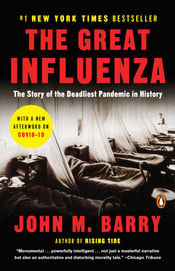
Title: The Great Influenza: The Story of the Deadliest Pandemic in History
Author: John M. Barry
Year: 2004
Genre: Nonfiction
What's It About?: The 1918 influenza pandemic (aka Spanish Flu), a global health crisis caused by an H1N1 strain of influenza A, is estimated to have infected 500 million people worldwide and led to the deaths of 50–100 million.
One Takeaway: Pandemic misinformation did not originate with COVID-19 … The “Spanish” flu originated on an army base in Kansas.

Title: Station Eleven
Author: Emily St. John Mandel
Year: 2014
Genre: Fiction
What's It About?: The story of a small group of traveling performers around the Great Lakes area in the aftermath of the “Georgia flu” decimating humanity.
One Takeaway: If a pandemic takes out 99% of the population, the lucky ones are not necessarily the survivors.

Title: World War Z: An Oral History of the Zombie War*
Author: Max Brooks
Year: 2006
Genre: Fiction
What's It About?: A virus causes a global zombie outbreak leading to a world war with nations fighting each other. This is an oral history with no central characters or plot line (aka ‘nothing like the movie’)
One Takeaway: In a zombie apocalypse, the value of sedentary knowledge workers (like us) drops to zero. Find at least one useful skill or nobody is going to let you into their compound.
*If you only pick one book on this list, make it this one!

Title: The Cobra Event
Author: Richard Preston
Year: 1998
Genre: Fiction
What's It About?: A fictional thriller about a bioterrorism attack in New York City involving a genetically engineered virus—a fusion of smallpox and the common cold.
One Takeaway: The Clinton story places this book at an interesting intersection of science, the arts, and government. A molecular biologist at a conference with Bill Clinton gave him the book, and his reading brought attention to the issue and ultimately changed public policy.

Title: The Demon in the Freezer: A True Story
Author: Richard Preston
Year: 2002
Genre: Nonfiction
What's It About?: This nonfiction book covers the potential for smallpox and anthrax to be used as bioterrorism weapons. It includes a history of the global smallpox eradication program.
One Takeaway: It turns out we did not actually eradicate smallpox from the planet, as there are at least two live samples (demons) waiting in the freezer—one in Atlanta at the CDC and the other in Moscow.
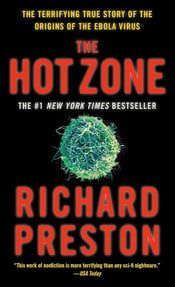
Title: The Hot Zone
Author: Richard Preston
Year: 1994
Genre: Nonfiction
What's It About?: The true story of an Ebola outbreak in a primate quarantine facility in suburban Washington, DC.
One Takeaway: If there is one silver lining in the gruesome way viral hemorrhagic fevers kill their hosts, it’s that they work so quickly they tend to burn out quickly so are hard to spread.

Title: The Stand
Author: Stephen King
Year: 1978
Genre: Fiction
What's It About?: A good versus evil horror story set in a post-apocalyptic world after a deadly virus, “Captain Trips,” kills 99.4% of the population.
One Takeaway: Good versus evil allegories aside, at a whopping 1,192 pages, having this book on the shelf will keep your brain occupied for long stretches during the next lockdown.
Do you have a favorite pandemic book to recommend? Email us at AskMarketing@ProAssurance.com and let us know why you recommend it.


Post-Pandemic Travel Budgeting Challenges
It was just over five years ago in March 2020; we huddled up in the Birmingham headquarters trying to make sense of the news—lockdown. Working from home, essential versus nonessential travel, unprecedented issues with many questions unanswered. One colleague said it'd last two weeks, another said June, but June seemed much too long; we quickly dismissed that. Whatever your prediction, ProAssurance continued to insure our physicians, hospitals, and others throughout the pandemic. We worked remotely, supported each other, and went through the next years with agility and resilience.
My team with the ProAssurance Medical Professional Liability division is responsible for financial planning and analysis (FP&A). While our division has many responsibilities, a critical one is the travel and entertainment (T&E) budget planning and expense management. While this has always been a bit of a moving target, the pandemic completely broke T&E planning, and five years later our “new normal” makes that a challenge.
In the first year of the remote working environment, we ‘beat the budget’ for T&E expenses by 77% with business travel coming to a complete stop. By ‘beat the budget’ we mean underspent the expected amount, so if the T&E expectation for 2020 was $100, we only spent $23. This was not a surprise for 2020; however, getting the right number in the past few years has remained challenging.

While we did achieve a gradual decrease in the favorable variance, the total period T&E expense during ‘The Blip’ is lower by 46%. Business travel remains an important part of our business; so why do we see this trend? What have we learned?
Leisure travel in our country came roaring back after the lockdown period but not business travel. To responsibly predict and manage expenses, we needed more understanding of how business travel changed. We can't tie actual dollars to root causes, but there are material changes in work culture and expectations.
- Technology – We all became a sort of subject-matter expert in online meeting software and suddenly realized what could be accomplished as a replacement to what previously was done in person.
- Decentralization – With the impacts of remote/hybrid environments, there is added friction to travel planning, i.e., an insurance company business development representative cannot visit an agency’s office if no one is there.
- Last-Minute Cancellations – With new waves of virus and shifting expectations about personal cost and risk, travelers today are more likely to cancel on short notice. While individuals may have previously shown up sneezing, a culture of public health sensitivity makes it more likely you’ll stay home.
- Competition – Leisure travel is booming, and there is a reduction in physical office space; the need to book third-party venues and find airline tickets is much tighter. Our event planners have us looking further into the future to simply find space.
- Demographics – New employees entering the job market have lower expectations and interest in work travel, while older generations who prized work travel are retiring.
A responsible FP&A means trying to understand practical cause and effect in order to help your organization best apply financial resources. As we head into the 2026 budget cycle, here are some things your agency planners can consider.
- Start by revisiting company policy and using the resources offered by your budget team like tracking tools, analysis of trends, and recommendations. Another starting point is the current budget and the upcoming trips you have lined up for the current year.
- Have a dialogue with your teams and understand how you can get the most value from in-person interactions with your business partners, suppliers, and stakeholders.
- Adjust to shifts in our industry or understand how the roles of your team members have changed in relation to business travel. Employ best practices, share knowledge, learn from each other, optimize available resources, and continue to evaluate the purpose of travel.
Our team members have done an excellent job of controlling company costs. However, the expense reduction alone will not help reduce the actual budget variance. It’s the refinement of the travel assumptions all of us employ in projecting next period’s expense. With every step we take toward more automation, there should be an equal step toward more valuable in-person interaction.


When Marketing Pivots to Crisis Communications
In March 2020, we were in the process of finalizing our conferences-themed issue of ProVisions when it became clear this was no longer a relevant topic. We quickly pivoted, adding a section about the “new virus” that was getting attention and, as so often is the case, moved onto the next project. We also added a “what we learned from COVID-19” issue in the May 2020 slot because we thought the situation would have wrapped up at that point.
It goes without saying that things continued in a very different direction than we had planned. As the situation continued to escalate to pandemic status, it became imperative to keep up with the overwhelming onslaught of information. The Marketing team met daily to go over what emergency measures had been enacted, company changes that needed to be communicated, laws that had been put on the books—as well as the swelling severity as the disease spread.
Marketing walked an increasingly fine line between keeping up morale and acknowledging all of the essential crisis communication needs. Overall, this resulted in a year-long internal and external campaign with several moving parts. While, thankfully, the severity of the topics the Marketing team has lessened since the height of the COVID-19 pandemic, the focus on providing timely, in-depth, and consistent information continues to be the primary focus for our work.
- COVID-themed articles in non-COVID issues – 9
- 9 LPS related
- 4 premium credit
- 4 risk management content
- 1 field hospital coverage
- 1 Winning Focus (physician stress/burnout coaching)
- 1 state mandated
- 12 LPS
- 5 senior care
- 4 risk management
- 1 state mandated
Risk Resource pages related to LPS – 6
Senior Care COVID-19 risk management – 2
Events page – Updated weekly starting mid-March 2020 through December 2020
COVID-themed web banners – 4
COVID-specific news items – 12
Daily of internet sites:
- DOI sites – 50 states
- Governor sites – 50 states
- Top 20 competitors
- Regular updates through September 2020
- Daily monitoring continued through December 2020
- Weekly monitoring in 2021
- Daily monitoring continued through December 2020
- State guidelines updated daily until page converted to risk management content in October 2020
- Updates continue as requested by Risk Management
- Daily monitoring continued through December 2020
- Weekly monitoring in 2021
- Info Center ad (2 versions) – 31 placed
- Thank You ad (3 versions) – 32 placed
- Web banners for associations – 9
- Twitter ad campaign – 1 (returning to practice, vaccine ad started in January 2021)
- Google Ad campaign – 1 (returning to practice)
Association specific, COVID-related eblasts – 3
Events
- 75+ edits to the Trade Shows and Events page due to cancellations or conversions to virtual events
- 3 of 6 National Shows moved to virtual (rest canceled)
- 15 LinkedIn
- 50 Twitter
Developed and distributed “Agent Appreciation” gift boxes
- Included branded COVID protection products (masks, wipes, sanitizer, and no-touch tools)
- Distributed at least 30 kits
Branded Zoom Backgrounds – 4
Assisted with webinars (replacements for in-person events) – 4

COVID-19 Impacts on Risk Management
COVID-19 significantly impacted the medical professional liability industry, including the Risk Management team at ProAssurance. Reflecting on the past five years since COVID-19, the role of the “Risk Management Consultant” has evolved. For Risk, the pivotal moment came when live Loss Prevention Seminars (LPS), onsite surveys, and in-person staff education were canceled. This was a significant change in direction for the many consultants who were hired to travel the country and deliver in-person education to physicians and practice managers.
Risk Management quickly adapted when live education was no longer an option due to canceled venue contracts, required social distancing, prohibited travel, and mandatory mask policies. The online version proved timely, convenient, and cost-effective. Even today, the 2025 LPS is a predominantly online-only offering, reflecting the long-lasting changes resulting from the COVID-19 pandemic.
At the same time education shifted to an online platform, onsite visits were also no longer an option, and the role of virtual surveys and assessments became essential.
Adaptations during the pandemic allowed Risk Management to rethink offerings and discover new ways to reach more insureds when there were no geographic limitations. In the early days of the pandemic, communications with practices were challenging due to limited in-person contact, but the creation of virtual tools ultimately led to the creation of the Annual Baseline Self-Assessment (ABSA) in 2023. This innovative solution then evolved to become the offering we have today that allows Risk to reach physicians, practice managers, and medical staff in a meaningful way. The ability to collect, aggregate, and analyze larger data sets, as well as provide actionable insights from a virtual platform, has led to a large-scale deployment of the ABSA nationwide.
During COVID-19, Risk prioritized supporting insureds on the front lines. The ProAssurance COVID-19 Resource Center provided real-time, state-specific information focused on patient safety concerns as well as deploying telemedicine for patient services at scale. The Risk Management Helpline became essential as doctors sought guidance on virus exposure and PPE shortages. Healthcare workers faced intense mental health strain due to infection fears, increased workloads, and the emotional toll of patient care. Patients and families became more demanding as hospitals struggled to provide timely and safe care. As a direct result of the challenges, Risk Management provided additional educational resources to address the new needs regarding burnout and communication.
I am proud of how Risk Management supported policyholders during this challenging time and how we continue to see the positive changes initiated by the pandemic.


Human Resources Weighs in Five Years After COVID-19
One could say ProAssurance was a little ahead of the curve when looking at remote work and hybrid work. Prior to COVID-19, a few areas of the company were working from home one to two days per week, and some were just beginning to test work from home. The move to full remote at the start of COVID-19 was dramatic.
ProAssurance offices remained remote only until early 2021, when buildings reopened for team members to have the option to return to an office, but it was not mandatory. Jumping to the present day, most teams work from home a majority of the time, if not fully. This move was in response to the hiring challenges ProAssurance, and other companies, faced in 2022. These challenges, coupled with the talent struggles the insurance industry was seeing, pushed ProAssurance to expand its geographic footprint to hire talent where we could find it. Out of more than 1,000 team members, approximately 45% of individuals are remote.
ProAssurance is among many companies that offer flexible work hours. In its February 2025 Insurance Labor Market Study, insurance talent The Jacobson Group reported that 83% of companies offer flexible work hours. The study found 78% of companies are anticipating most individuals to be in office at least one day a week in the next six months. Eighty-eight percent of the companies polled do not foresee a change in their current model, and 11% are expecting employees to be required in the office more often.
What about the next global pandemic? Human Resources Vice President Marcie Claas says, “We feel we are prepared to respond well if we find ourselves in a similar position again. So much of what we learned and how we changed through COVID-19 is in the fabric of our company and how we operate each day.” She touched on ProAssurance’s flexible structure being an asset, with minimal transition if team members had to work from home consistently. She said the current work structure and resources in place would help managers and their teams confidently transition to a fully remote work model.
Existing ProAssurance Office Space
The pandemic influenced ProAssurance to close 10 offices, or around 15% of the company’s rentable square footage (RSF). Through lease attrition over the past five years, we closed a total of 89,048 RSF of office space and reduced our lease obligations by 44,325 RSF by rightsizing leased office locations, resulting in a total 133,373 RSF decrease. For perspective, that amount is twice as much space as we have in Lancaster and exceeds square footage in the five floors we occupy in our Birmingham headquarters. We now rent office space totaling 153,050 RSF, which is a 47% decrease in rented office space since 2020.
As of late March 2025, we own 217,444 square feet of office space. This amount includes a 31% reduction with the recent sale of the Franklin, Tennessee, office.



The Bind Order
This selection of accounts ProAssurance bound recently is intended to give our partners tangible examples of risk classes we’ve been successful quoting and that we’d like to see more of. These examples are anonymized with final premium rounded, but otherwise present actual accounts.
|
FAMILY PHYSICIAN Nevada DERMATOLOGY Colorado OTORHINOLARYNGOLOGY New Jersey |
PSYCHIATRY California INTERNAL MEDICINE Texas PULMONARY DISEASES Wisconsin |
ORTHOPEDIC
Kansas NEUROLOGY Florida PLASTIC SURGERY Florida |
CERTIFIED NURSE PRACTITIONER
Florida
Limits: 1M/3M
E&S Premium: $3,058
SENIOR LIVING
Massachusetts
Limits: 1M/3M
E&S Premium: $89,000
PAIN MANAGEMENT
Pennsylvania
Limits: 500k/1.5M
Admitted
Premium: $9,552
ONCOLOGY
Texas
Limits: 500k/1.5M
Admitted
Premium: $7,244
PEDIATRICS
Wisconsin
Limits: 1M/3M
Admitted
Premium: $3,331
HOSPICE
Georgia
Limits: 1M/3M
E&S Premium: $18,400
LABORATORY
New Jersey
Limits: 1M/3M
E&S Premium: $19,275
New Business Submissions
Our standard business intake address for submissions is Submissions@ProAssurance.com. For specialty lines of business, please use one of the following: CustomPhysicians@ProAssurance.com, Hospitals@ProAssurance.com, MiscMedSubs@ProAssurance.com, and SeniorCare@ProAssurance.com. Visit our Producer Guide for additional information on our specialty lines of business.
News Updates - Then & Now
In May 2020, Reuters reported that companies largely feared COVID-19 liability lawsuits. By the end of the year, federal and state laws were limiting liability related to COVID-19 care (“COVID-19 Liability: Tort, Workplace Safety, and Securities Law,” Congress.gov).
We initially shared that Lloyd’s of London expected COVID-19 claims to match 9/11. In January 2022, Reuters reported that insured losses from COVID-19 had reached $44 billion, representing the third-largest cost to insurers of any catastrophe (behind Hurricane Katrina and 9/11).
Modern Healthcare reported in May 2020 that the healthcare sector lost 1.4 million jobs in April 2020. By the end of 2022, most of those jobs were recovered, according to Healthcare Dive.
.png?width=300&name=MicrosoftTeams-image%20(28).png)
Overall, data compiled from many countries shows that in 2020, on average, around 1 in 140 people infected died from COVID-19. In this article, we review the key insights from global data on COVID-19. (Our World in Data)

Decades from now, the pandemic will be visible in the historical data of nearly anything measurable today: an unmistakable spike, dip, or jolt that officially began for Americans in March 2020. (New York Times)



A research group found the following regarding the effects of the COVID-19 pandemic:
- Cancer screening participation decreased by 39%.
- Diagnoses decreased by 23%.
- Diagnostic procedures decreased by 24%.
- Disease treatment decreased by 28%—ranging from a 15% decline for radiotherapy to a 35% decline for systemic treatment during the pandemic compared with the pre-pandemic period.
- Medium-human development index (HDI) category countries experienced greater reductions than high- and very-high-HDI countries. (The HDI is a summary measure of average achievement in key facets of human development, including a long and healthy life, being knowledgeable, and having a decent standard of living.)
(Science and Medicine Group)
Average hospital occupancy rates were up 11% in 2024 compared to 2019, due mostly to a declining supply of staffed beds rather than an increase in hospitalizations. The average supply of staffed beds fell from 802,000 beds between 2009 and 2019 to 674,000 beds between May 2023 and April 2024. (Healthcare Dive)
For the week ending on January 25, nearly 1.7% of all deaths nationwide were attributed to the flu, compared to roughly 1.5% being the result of COVID-19, according to CDC data. Rates of influenza hospitalizations are more than three times higher than COVID-19 hospitalizations amid this season's record wave of flu infections. (CBS)

The Blip that Became the Blueprint: A Five-Year Retrospective on Selling in the Post-Pandemic World

What started as “The Blip” has fundamentally transformed how salespeople approach healthcare providers. While it might feel as though things are back to normal, comparing the pre- and post-pandemic business landscape reveals things have changed. If you’re still trying to sell like you did in 2019, it might be working, but chances are, it’s not working as well. Let’s look at these changes and what’s required to remain competitive.
The New Gatekeeping Reality
If you ask medical sales reps what’s changed since the pandemic, they’ll likely tell you that healthcare providers are more protective of their time. Pre-pandemic, a sales rep could grab a few minutes of a provider’s time by dropping in with lunch or a new widget. Today, lunch needs to be served with a solution to an urgent priority, or you’re not getting past the front desk.
While liability risk is a subject that gets the attention of HCPs, generic presentations about “potential liability issues” don’t cut it anymore. Today’s providers need you to address precise concerns relevant to their specialty, patient population, or specific technologies they use, not your products’ general benefits.
What HCPs Care About Now
While sales calls previously focused mainly on product issues, conversations have shifted. Doctors and other HCPs are more open to discussing:
- Staffing volatility and the resulting liability concerns
- Achieving financial sustainability during an era of declining reimbursement
- Integrating technologies that introduce new layers of risk
- Patient expectations that are more focused on care access and communication
- Expanding regulatory compliance burdens that consume administrative resources
- Cybersecurity threats
- Practice consolidation pressures (for the diminishing number of independent providers remaining)
Agents who deeply understand these challenges stand out from the crowd. The most successful sales professionals have aligned their value propositions around these and other evolving concerns rather than just focusing on a product.
Information Is Your New Currency
Relationships still matter with HCPs, but the basis has shifted. Providers gravitate more toward partners who deliver meaningful insights than those who are merely friendly.
Outreach around relevant data, case studies, and trend analyses are more likely to capture attention. By sharing intelligence about emerging risks, regulatory changes, or litigation trends, you position yourself as a true consultant instead of just another vendor.
This information-first approach serves a dual purpose. It keeps you top-of-mind when clients aren’t actively considering renewals or exploring coverage changes. More importantly, it positions you as helping clients identify emerging risk areas and potential coverage needs before they become urgent problems requiring immediate attention.
Building Resilience Into Your Sales Approach
One lesson from the pandemic is the importance of adaptability in the sales process itself. The sales professionals who thrived during the peak of COVID-19 were those who quickly pivoted to digital. This shift didn’t just change how providers operated, it changed how providers expected to interact with partners.
Adapting requires something beyond mere technical skills; it requires emotional intelligence. HCPs are experiencing levels of fatigue and uncertainty like never before. Agents who acknowledge this reality and approach conversations with genuine empathy create connections beyond traditional business relationships.
The pandemic didn’t just move the goalposts—it built an entirely new playing field. Yet the game remains oddly familiar: deliver truly personalized value, and you’ll win. Only now, healthcare providers define the meaning of value, and they’re not accepting substitute definitions.

|
Written by Mace Horoff of Medical Sales Performance. Mace Horoff is a representative of Sales Pilot. He helps sales teams and individual representatives who sell medical devices, pharmaceuticals, biotechnology, healthcare services, and other healthcare-related products to sell more and earn more by employing a specialized healthcare system. Have a topic you’d like to see covered? Email your suggestions to AskMarketing@ProAssurance.com. |
Notice of Rate Changes
 We are committed to responsible pricing that reflects the current risk environment. A review of our rate plan and rating factors has resulted in an updated rate strategy for new and renewal accounts in the states listed below.
We are committed to responsible pricing that reflects the current risk environment. A review of our rate plan and rating factors has resulted in an updated rate strategy for new and renewal accounts in the states listed below.
The following updates, which have been filed and approved, may impact insureds. Note the carrier and effective dates below:
DELAWARE (NORCAL, effective April 1, 2025)
A base rate increase of 8.0%. After revisions to some classes and specialties, the overall rate change is 11.9%.
DELAWARE (ProAssurance, effective May 1, 2025)
A base rate increase of 4.4%. After revisions to some classes and specialties, the overall rate change is 7.6%.
PENNSYLVANIA (NORCAL, effective May 1, 2025)
A base rate increase of 4.8%. After revisions to some classes, specialties, and territories, the overall rate change is 7.8%.
FLORIDA (NORCAL, effective May 1, 2025)
No base rate change. After revisions to territories, credit eligibility, and some classes, the overall rate change is 2.7%.



